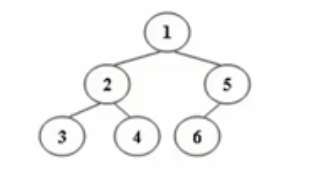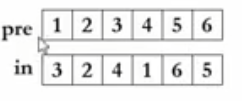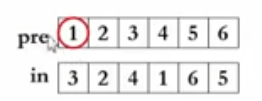题目链接
讲解链接(陈越姥姥yyds)
题目图片

输入输出示例

思路:
将树画出来,

将压栈、入栈操作分别列出

有没有发现,其实压栈顺序就是先序遍历顺序,而出栈顺序则是中序遍历顺序!!!,中序遍历操作,pop顺序就是中序遍历顺序,不难理解,那为啥push顺序刚好是先序遍历捏?
因为为我们每次遇到一个节点都需要先保存下来(即压栈),然后再去找左子树,这样在弹出栈时才能让左子树先弹,达到先序遍历的效果。
所以我们就这样得到了树的pre、in顺序的遍历。
那么,怎样仅用这两个顺序就得到后序遍历呢?
首先,我们要明确,先序遍历时数字肯定是按照
根节点 | 左子树元素 | 右子树元素的顺序排列的

现在根节点已经确定了,怎样分开pre数组中左子树和右子树元素呢?
这就要用到in数组了

发现没有?in里面根节点左边3个就是左子树元素,右边两个就是右子树元素
现在,既然我们有了将pre 和in数组里根节点、左子树、右子树分开的办法,那我们是不是就可以递归的在in数组里找右子树并打印出来呢?
下面给出建树的办法,来自大佬余-cos的代码
#include <iostream>
#include <string>
#include <queue>
#include <stack>
typedef int Tree;
using namespace std;
#define maxsize 35
#define Null -1
int N,x;
int cnt=0;
typedef int tree;
struct TNode{
int data;
tree left,right;
}T1[maxsize];
stack<char> s;
int c2i(char ch){
return ch-'0';
}
Tree Rebuild(string preod,string inod)
{
Tree R;//当前树的根节点
if(preod.empty()&&inod.empty())return Null;
R=c2i(preod[0]);;
int l,r,Rindex,len;//左子树大小,右子树大小,根节点位置,当前树长度
len=preod.length();
Rindex=inod.find(preod[0],0);
l=Rindex;
r=len-1-Rindex;
if(Rindex!=0)
{
T1[R].left=Rebuild(preod.substr(1,l),inod.substr(0,l));
}
else
{
T1[R].left=Null;
}
if(Rindex!=len-1)
{
T1[R].right=Rebuild(preod.substr(Rindex+1,r),inod.substr(Rindex+1,r));
}
else
{
T1[R].right=Null;
}
return R;
}
void PostOrderTraversal(Tree R)
{
if(R==Null)return;
PostOrderTraversal(T1[R].left);
PostOrderTraversal(T1[R].right);
if(cnt==0)cout<<R;
else cout<<" "<<R;
cnt++;
}
string o;
int main()
{
string preod,inod;
char ch;
cin>>N;
getchar();
int n=2*N;
for(int i=0;i<n;++i)
{
cin>>o;
if(o=="Push"){
cin>>x;
ch=x+'0';
s.push(ch);
preod+=ch;
}else{
inod+=s.top();
s.pop();
}
getchar();
}
Tree R1;
R1=Rebuild(preod,inod);
PostOrderTraversal(R1);
//cout<<endl;
system("pause");
return 0;
}
接下来是不建树的办法
#include <iostream>
#include <vector>
#include <string>
#include <stack>
#include <algorithm>
using namespace std;
int N,cnt=0;
void posttravel(vector<int>&in,vector<int>&pre,int R,int rear,int R_in,int rear_in)
{
int root=R;
int i;
if(root>rear)return;
if(root==rear)
{
cout<<pre[root];
cnt++;
if(cnt!=N)
cout<<" ";
return;
}
for ( i = R_in; i <= rear_in; i++)
{
if(in[i]==pre[root])
{
break;//i为in中根节点位置
}
}
posttravel(in,pre,root+1,root+i-R_in,R_in,i-1);
posttravel(in,pre,root+i-R_in+1,rear,i+1,rear_in);
cout<<pre[root];
cnt++;
if(cnt!=N)
cout<<" ";
return;
}
int main()
{
int n;
string oper;
cin>>n;
int tmp;
vector<int> in;
vector<int> pre;
stack <int> s;
for(int i=0;i<n*2;i++)
{
cin>>oper;
if(oper=="Push")
{
cin>>tmp;
pre.push_back(tmp);
s.push(tmp);
}
else
{
in.push_back(s.top());
s.pop();
}
}
N=in.size();
posttravel(in,pre,0,pre.size()-1,0,in.size()-1);
//system("pause");//用于查看测试结果
return 0;
}
两种版本代码皆可通过所有测试用例
P.S 对数组边界不够敏感,还得多练习啊T_T